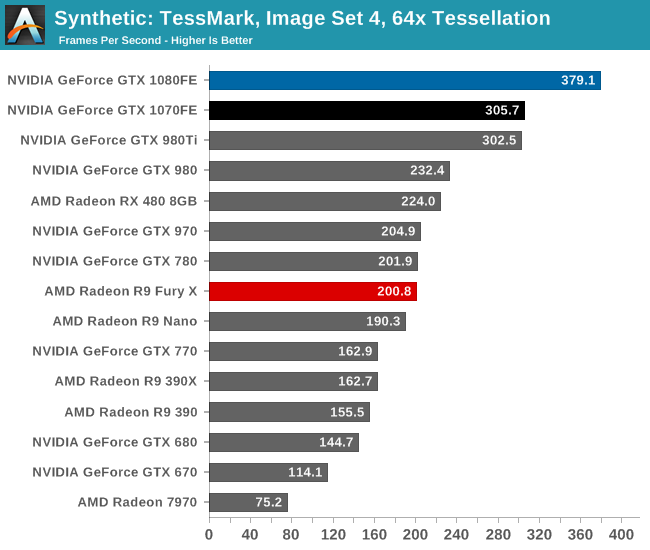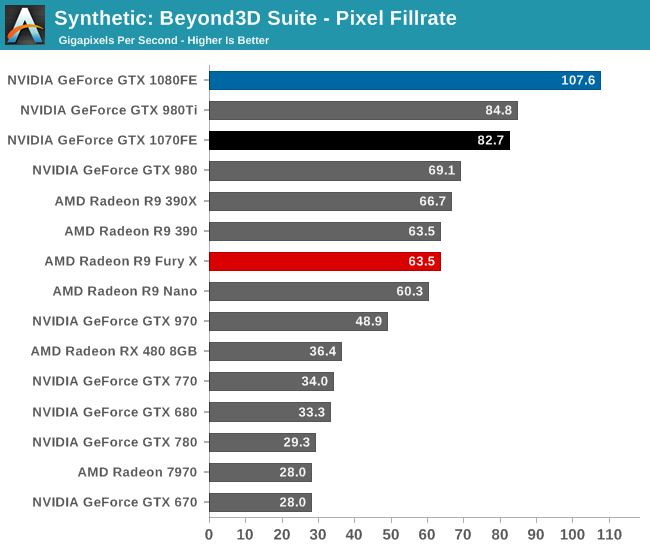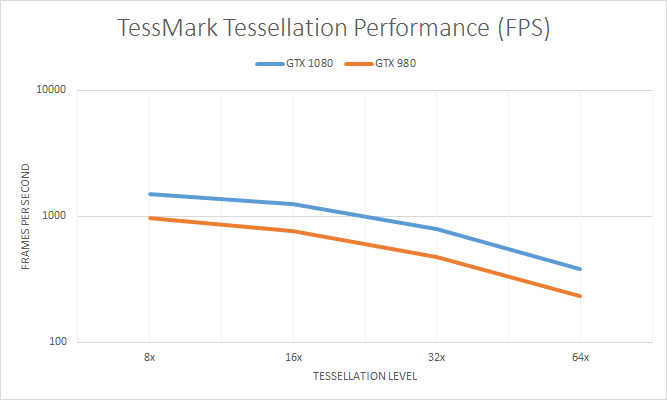The NVIDIA GeForce GTX 1080 & GTX 1070 Founders Editions Review: Kicking Off the FinFET Generation
by Ryan Smith on July 20, 2016 8:45 AM ESTSynthetics
Though we’ve covered bits and pieces of synthetic performance when discussing aspects of the Pascal architecture, before we move on to power testing I want to take a deeper look at synthetic performance. Based on what we know about the Pascal architecture we should have a good idea of what to expect, but these tests none the less serve as a canary for any architectural changes we may have missed.

Starting off with tessellation performance, we find that the GTX 1080 further builds on NVIDIA’s already impressive tessellation performance. Unrivaled at this point, GTX 1080 delivers a 63% increase in tessellation performance here, and maintains a 24% lead over GTX 1070. Suffice it to say, the Pascal cards will have no trouble keeping up with geometry needs in games for a long time to come.
Breaking down performance by tessellation level to look at the GTX 980 and GTX 1080 more closely on a logarithmic scale, what we find is that there’s a rather consistent advantage for the GTX 1080 at all tessellation levels. Even 8x tessellation is still 56% faster. This indicates that NVIDIA hasn’t made any fundamental changes to their geometry hardware (PolyMorph Engines) between Maxwell 2 and Pascal. Everything has simply been scaled up in clockspeed and scaled out in the total number of engines. Though I will note that the performance gains are less than the theoretical maximum, so we're not seeing perfect scaling by any means.
Up next, we have SteamVR’s Performance Test. While this test is based on the latest version of Valve’s Source engine, the test itself is purely synthetic, designed to test the suitability of systems for VR, making it our sole VR-focused test at this time. It should be noted that the results in this test are not linear, and furthermore the score is capped at 11. Of particular note, cards that fail to reach GTX 970/R9 290 levels fall off of a cliff rather quickly. So test results should be interpreted a little differently.

With the minimum recommended GTX 970 and Radeon R9 290 cards get in the mid-to-high 6 range, NVIDIA’s new Pascal cards max out the score at 11. Which for the purposes of this test means that both cards exceed Valve’s recommended specifications, making them capable of running Valve’s VR software at maximum quality with no performance issues.
Finally, for looking at texel and pixel fillrate, for 2016 we have switched from the rather old 3DMark Vantage to the Beyond3D Test Suite. This test offers a slew of additional tests – many of which use behind the scenes or in our earlier architectural analysis – but for now we’ll stick to simple pixel and texel fillrates.

Starting with pixel fillrate, the GTX 1080 is well in the lead. While at 64 ROPs GP104 has fewer ROPs than the GM200 based GTX 980 Ti, it more than makes up for the difference with significantly higher clockspeeds. Similarly, when it comes to feeding those ROPs, GP104’s narrower memory bus is more than offset with the use of 10Gbps GDDR5X. But even then the two should be closer than this on paper, so the GTX 1080 is exceeding expectations.
As we discovered in 2014 with Maxwell 2, NVIDIA’s Delta Color Compression technology has a huge impact on pixel fillrate testing. So most likely what we’re seeing here is Pascal’s 4th generation DCC in action, helping GTX 1080 further compress its buffers and squeeze more performance out of the ROPs.
Though with that in mind, it’s interesting to note that even with an additional generation of DCC, this really only helps NVIDIA keep pace. The actual performance gains here versus GTX 980 are 56%, not too far removed from the gains we see in games and well below the theoretical difference in FLOPs. So despite the increase in pixel throughput due to architectural efficiency, it’s really only enough to help keep up with the other areas of the more powerful Pascal GPU.
As for GTX 1070, things are a bit different. The card has all of the ROPs of GTX 1080 and 80% of the memory bandwidth, however what it doesn’t have is GP104’s 4th GPC. Home of the Raster Engine responsible for rasterization, GTX 1070 can only setup 48 pixels/clock to begin with, despite the fact that the ROPs can accept 64 pixels. As a result it takes a significant hit here, delivering 77% of GTX 1080’s pixel throughput. With all of that said, the fact that in-game performance is closer than this is a reminder to the fact that while pixel throughput is an important part of game performance, it’s often not the bottleneck.

As for INT8 texel fillrates, the results are much more straightforward. GTX 1080’s improvement over GTX 980 in texel throughput almost perfectly matches the theoretical improvement we’d expect based on the specifications (if not slightly exceeding it), delivering an 85% boost. As a result it’s now the top card in our charts for texel throughput, dethroning the still-potent Fury X. Meanwhile GTX 1070 backs off a bit from these gains, as we’d expect, as a consequence of having only three-quarters the number of texture units.











200 Comments
View All Comments
Scali - Wednesday, July 27, 2016 - link
There is hardware to quickly swap task contexts to/from VRAM.The driver can signal when a task needs to be pre-empted, which it can now do at any pixel/instruction.
If I understand Dynamic Load Balancing correctly, you can queue up tasks from the compute partition on the graphics partition, which will start running automatically once the graphics task has completed. It sounds like this is actually done without any interference from the driver.
tamalero - Friday, July 22, 2016 - link
I swear the whole 1080 vs 480X remind me of the old fight between the 8800 and the 2900XTwhich somewhat improved int he 3870 and end with a winner whit the 4870.
I really hope AMD stops messing with the ATI division and lets them drop a winner.
AMD has been sinking ATI and making ATI carry the goddarn load of AMD's processor division failure.
doggface - Friday, July 22, 2016 - link
Excellent article Ryan. I have been reading for several days whenever i can catch five minutes, and it has been quite the read! I look forward to the polaris review.I feel like u should bench these cards day 1, so that the whingers get it out od their system. Then label these reviews the "gp104" review, etc. It really was about the chip and board more than the specific cards....
PolarisOrbit - Saturday, July 23, 2016 - link
After reading the page about Simultaneous Multi Projection, I had a question of whether this feature could be used for more efficiently rendering reflections, like on a mirror or the surface of water. Does anyone know?KoolAidMan1 - Saturday, July 23, 2016 - link
Great review guys, in-depth and unbiased as always.On that note, the anger from a few AMD fanboys is hilarious, almost as funny as how pissed off the Google fanboys get whenever Anandtech dares say anything positive about an Apple product.
Love my EVGA GTX 1080 SC, blistering performance, couldn't be happier with it
prisonerX - Sunday, July 24, 2016 - link
Be careful, you might smug yourself to death.KoolAidMan1 - Monday, July 25, 2016 - link
Spotted the fanboy apologistbill44 - Monday, July 25, 2016 - link
Anyone here knows at least the supported audio sampling rates? If not, I think my best bet is going with AMD (which I'm sure supports 88.2 & 176.4 KHz).Anato - Monday, July 25, 2016 - link
Thanks for the review! Waited it long, read other's and then come this, this was the best!Squuiid - Tuesday, July 26, 2016 - link
Here's my Time Spy result in 3DMark for anyone interested in what an X5690 Mac Pro can do with a 1080 running in PCIe 1.1 in Windows 10.http://www.3dmark.com/3dm/13607976?